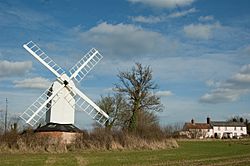Bragg's Mill, Ashdon facts for kids
Quick facts for kids Ashdon Windmill |
|
|---|---|

Bragg's Mill in 2009
|
|
| Origin | |
| Mill name | Bragg's Mill, William Bragg's Mill Bartlow Hamlet Mill Stevington End Mill |
| Grid reference | TL 595 425 |
| Coordinates | 52°03′30″N 0°19′33″E / 52.0584°N 0.3258°E |
| Operator(s) | Ashdon Windmill Trust |
| Year built | 1757 |
| Information | |
| Purpose | Corn mill |
| Type | Post mill |
| Roundhouse storeys | Single storey roundhouse |
| No. of sails | Four Sails |
| Type of sails | Patent sails |
| Windshaft | Wooden windshaft, cast iron poll end |
| Winding | Tailpole |
Bragg's Mill is a special type of windmill called a post mill. It's also known by other names like William Bragg's Mill or Stevington End Mill. This historic mill is located in Ashdon, Essex, England, and has been carefully restored to its former glory. It is considered a very important building, listed as a grade II historic site.
Contents
History of Bragg's Mill
Bragg's Mill was built in 1757 by a carpenter named William Haylock, who lived in Ashdon. In 1813, the mill was put up for sale. At that time, it had two pairs of large grinding stones, called millstones. Back then, it was an 'open trestle mill', meaning its base was open to the elements.
Around 1815, the mill was made a bit longer at the back. Then, about five years later, a roundhouse was added around its base. The mill continued working until about 1912. By 1932, parts of the mill were failing, and it needed props to stay standing.
The mill was repaired in the late 1950s. However, by 1974, it was in bad shape again, and more repairs were done. In the 1990s, the large sails were taken off.
How the Mill Was Restored
In April 1999, people from the village had a meeting. They all agreed that the windmill should be fixed up, and that new sails should be put back on. Because of this, the Ashdon Windmill Trust Ltd was created. It became a registered charity. They got permission to do the work, as it's a listed building.
In 2000, the Thurlow Estate, which owned the mill, gave it to Ashdon village. They also promised to donate £25,000 once the Trust had raised the same amount of money. In 2001, the Essex Environment Trust gave a grant of £40,000.
The restoration work on the mill began in March 2002. A specialist named Vincent Pargeter was hired to do the repairs. The mill's frame was straightened, and its outside was completely covered with new wooden boards. By 2004, the mill looked amazing with a fresh coat of white paint. In July 2004, the project received another big grant of £46,900 from the Heritage Lottery Fund. Finally, new sails were put on the mill on July 5, 2006.
What Bragg's Mill Looks Like
Bragg's Mill is a post mill, which means the whole top part of the mill can turn on a central post to face the wind. It has a single-storey roundhouse at its base. The mill has four special patent sails. These sails are attached to a wooden shaft that has a metal end. Two of the sails have double shutters, and two have single shutters.
The mill uses two pairs of millstones to grind grain. The mill is turned into the wind using a long wooden pole called a tailpole. The mill stands about 34 feet (10.36 meters) tall to its roof.
The Mill's Base and Roundhouse
The main wooden beams at the bottom of the mill, called crosstrees, are very close to the ground. The brick supports they rest on were once covered in tar and the crosstrees painted white. This shows that the mill was originally built with an open base. Both crosstrees are made of strong oak wood. The main post, which the whole mill body sits on, is about 17 feet 6 inches (5.33 meters) long.
The Mill's Body
The main part of the mill, called the body, is about 19 feet 10 inches (6.05 meters) long and 11 feet (3.35 meters) wide. At some point, the back of the mill's body was made longer. This was done to make space for a machine called a bolter, which helps to sift flour. Originally, the body was only about 16 feet 6 inches (5.03 meters) long.
Sails and Windshaft
The windshaft, which is the main axle that the sails turn, is made of wood. It has a cast iron (metal) end. This metal end was probably added when the special patent sails were put on. When the mill was first built, it would have had simpler sails.
Inside the Mill: Machinery
The large wooden wheel inside the mill, called the head wheel, is about 7 feet 4 inches (2.24 meters) across. It was changed from an older design to its current clasp arm style. The wooden tail wheel is also about 6 feet 4 inches (1.93 meters) across and was changed in a similar way. The mill was first built with only one pair of millstones. The second pair was likely added when the mill was made longer at the back.
Millers Who Worked Here
Over the years, many people worked at Bragg's Mill. Here are some of the millers:
- Josiah Giblin (1809 - 1819)
- John Ruse (1830)
- John Brown (1848)
- Frederick and John Ruse (1850)
- John Bragg (1898)
- William Bragg (1894 - 1912)
Bragg's Mill in Books
In its last years of working, Bragg's Mill was mentioned in a book called Five Miles from Bunkum.
Visiting the Mill
You can visit Bragg's Mill! It is open to the public on the second Sunday of each month, starting in April every year.


